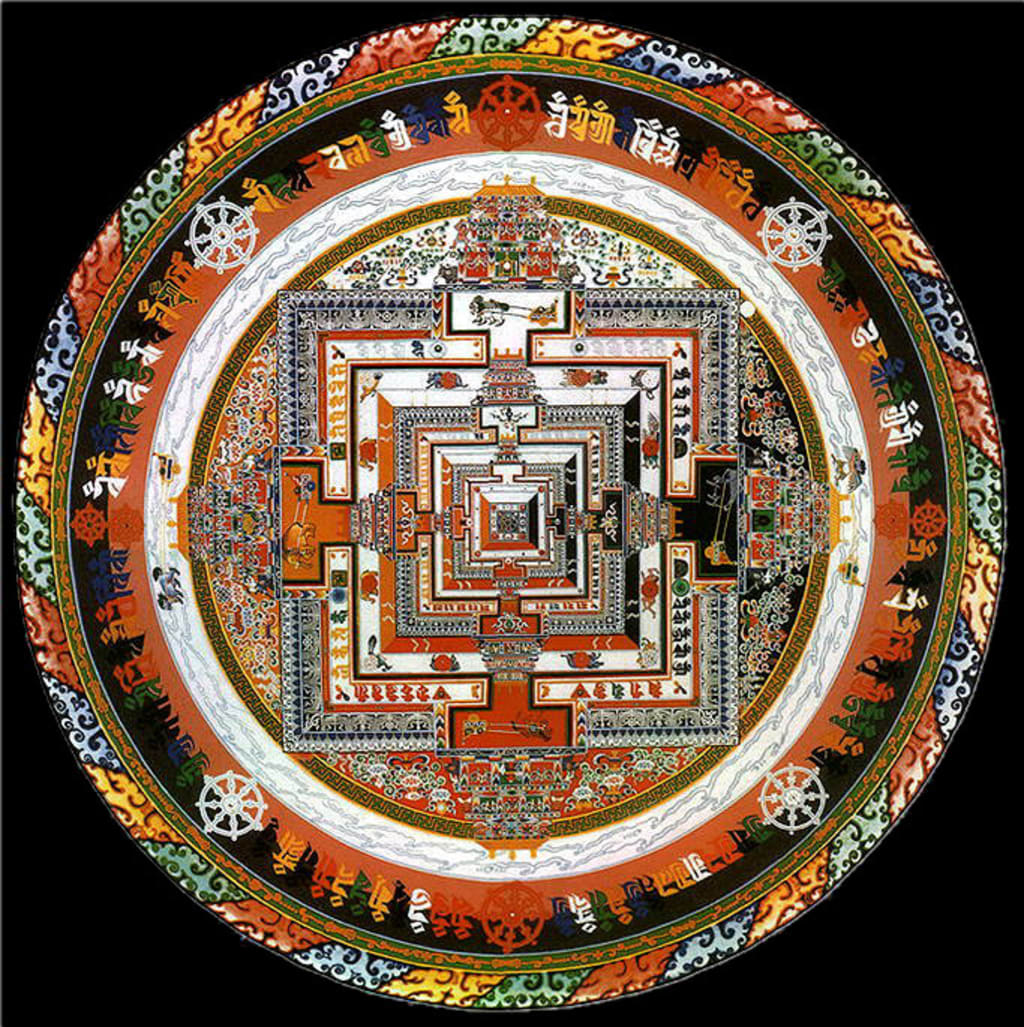
Although contemporary sand mandalas are not created with the same exact ritual practices as the older mandalas, Tibetan sand mandalas are rooted in the same traditions as the mandalas on wall scrolls of previous generations. Both sets of mandalas are rooted in traditional Buddhist practice and have the same intended religious meaning, although the symbolic natures are different. As an example of this, I will be comparing The Kalachakra Mandala: Man and Cosmos scroll (Rubens Museum Exhibition) and The Kalachakra Mandala, otherwise known as The Wheel of Time Sand Mandala.
To begin with, some background information on Tibetan mandalas is necessary. Tibetan mandalas have their own set of artistic conventions that differ from other Buddhist mandalas.
Tibetan mandalas gradually become one of the visual means of portraying… perfect, celestial worlds… Of particular importance to Tibetans is the Pure Land of Shambhala, a mythical kingdom hidden among the highest mountains north of Tibet and attainable only by those pure of heart, entirely untouched by anger and ignorance. Shambhala is the subject of elaborate, often mandala-like, paintings composed of ideal monasteries set in the perfect harmony of nature and deities. (Fisher 38-39)
Shambhala as a subject is not particularly relevant to the Kalachakra Mandalas I will compare. However, there is importance in the idea of a mandala representing the blueprint of a palace or monastery as it originates in the Tibetan Buddhist style of art. These traditions and artistic conventions have come to light very recently. This is because previously, Tibetan monks were the only ones allowed to know the traditions. However, Tibetan culture has become a topic of research as of late, due to worry that the Tibetan Buddhist culture may die out with the current Dalai Lama. For this reason, Tibetan art has become more easily accessible to western viewers who wish to study the current art practices in hopes that knowledge of these practices will help spread Tibetan Buddhist traditions to the west. (Stoddard 171)
Now knowing where this information on Tibetan Buddhist art is coming from, we can get into the comparison between scroll mandalas and sand mandalas. In particular for the scroll mandalas, I will discuss the Kalachakra Mandala: Man and Cosmos scroll. The reason that the ‘man and cosmos’ part of this scroll’s name is important is for differentiation among all of the other Kalachakra mandalas in the Rubens Museum Collection. Kalachakra is a Buddhist deity and thus has many mandalas depicting the palace in which this deity lives as well as this deity’s life and teachings.
The Kalachakra Tantra, from which this scroll is derived, clearly develops the concept of structural correlations and parallels among all things, in particular the connection between the universe, the mandala, and the human body. (Brauen 70)
This differs from the Kalachakra teachings depicted in the Wheel of Time Sand Mandala because the message of the deity that is being evoked in that mandala, is one that emphasizes the importance of kindness and compassion rather than the unity of the universe (Bryant 84). In fact, it is the difference in message and subject matter that is the biggest distinction between scroll and sand mandalas, although as western viewers, without knowing the symbolism, it is difficult to notice this change.
Painted [Tibetan] mandalas exhibit the greatest range of subject matter and pictorial inventiveness, from images consisting of entirely geometric shapes, without humans or deities, to multiple mandalas in the same composition. (Fisher 70-71)
This quote is referencing the difference among mandalas of different cultures, but it also applies to the difference among the mandalas within Tibet as well. Certain mandala symbols are influenced by Indian traditions and others are influenced by Chinese and Japanese traditions. For this reason, Tibetan mandalas have a unique take on how a mandala should be constructed.
In dictionaries mandalas are described as variously as magic circles, round ritual geometric or symbolic diagrams, or typically, circles that surround a square with a central symbol, which may be a numeral. Alternatively, mandalas are explained as symbols of the cosmic elements, as models for certain visualizations, as aids to self-discovery, or as aids to meditation on the transcendental. All of these definitions are correct as far as they go but are not nearly precise enough…. (Brauen 11)
The contrast in these definitions of what a mandala is and should represent is also due to this passing on of tradition from one culture to the next. The fact that these definitions are not precise enough is due to their spiritual nature- an individual may define these objects through words, but the meaning behind the symbols that are rooted in centuries of tradition will never come across in those words.
Today, most viewers would recognize the bright colors of a sand mandala as opposed to the muted colors of a Tibetan scroll. This is partly due to the materials that make up a Tibetan scroll versus those that make up a sand mandala.
Traditionally, in ancient times, the Indian Buddhist sand painters used their fingers to apply sand, as monks in some Tibetan monasteries do today. The chakpus [long metal funnel for applying sand] used by the Namgyal monks were invented in the eighteenth century by the Tibetans. (Leidy 154)
This is yet another difference between the scrolls and the sand mandalas. Not only is the message between the two styles different (due to symbols traditionally used in each medium), there is also a difference between the materials. This much should be obvious in the name “scroll” and “sand” mandala, however those materials are used for different reasons. These reasons are not simply stylistic; they are based on as much ritual as the mandala itself.
It is important to note that the mandala is explicitly based on the scriptural text, and that there is no creative invention along the way. Any creative inspiration is manifested within the perfecting of the skill. (Leidy 154)
The reason for this is that the monks believe the mandala is a representation of Buddha’s teachings, and thus the more accurate to the text, the more effective the teaching comes across in the mandala. Scroll mandalas and sand mandalas reference different traditional texts, so they need to have different symbolic meaning and different functions- even if they represent the same Buddhist teachings.
Turning now to the sand mandala, one of the biggest differences between the sand mandala and any other medium is the ritual destruction that symbolizes the fleeting nature of life. This differs from other mandala forms, because generally a painting or scroll is kept for many generations. A flat painted copy of a sand mandala may be created as a form of memory, but the physical mandala made of sand is destructed as part of the meditation ceremony (Leidy 162). This aspect of ritual destruction is important because thus far the creation of both of the mandalas has been very similar. The mandala is created in reference to Buddhist text in a blueprint-like format for the purpose of meditation, even if the symbols and texts are different. This destruction is a piece that is unique to sand mandala tradition. The sand remaining after the mandala is used in purification ceremonies later, which is another thing that cannot be said about the scroll mandalas.
At the closing ceremonies the monks offered a vase filled with blessed sand from the Fire Offering Sand Mandala [inner circle of the Wheel of Time Mandala] to the endangered streams of the Rocky Mountains. Another was given… the next day as an offering to the marine life threatened by the Exxon Valdez oil spill. The Wheel of Time was continuing to expand its reach deep into the culture of the 20th century. (Bryant 37)
In this way, we begin to see a new tradition in contemporary times emerge from the symbols of ancient teachings. While the mandala is not a new art, sand mandalas are a relatively contemporary form of creating mandalas. The tradition of creation is thus rooted in the same traditions that make the scroll. However, the destruction and purification aspects of the ritual are rooted in other traditions of Buddhism and are relatively new in Tibetan Buddhist art.
Thus, we see that Tibetan Buddhist sand mandalas are rooted in similar traditions to ancient scroll making practices, but they differ in many ways. These differences lead scholars to think that sand mandalas are a contemporary reflection on the changing nature of Tibetan Buddhist practice as it continues into today. Sand mandalas and older scrolls have the same religious intention as previous practice, but they differ in their respective mediums and the way in which they both express ancient text.
Bibliography
Brauen, Martin. "Mandala: The Perfect Circle." Arts of Asia 40, no. 2 (2010): 69-81. Accessed November 24, 2014. Ebsco.
---, Karl Debreczeny, Amy Heller, Edward Henning, Christian Luczanits, Ariana Maki, Marylin Rhie, Michael R. Sheehy, and Jeff Watt. Mandala: Sacred Circle in Tibetan Buddhism. Arnoldsche Art Publishers.
Bryant, Barry. The Wheel of Time Sand Mandala: Visual Scripture of Tibetan Buddhism. San Francisco: Harper, 1992.
Fisher, Robert E. Art of Tibet. London: Thames & Hudson, 1997.
Leidy, Denise Patry, and Robert A. F. Thurman. Mandala: The Architecture of Enlightenment. New York: Asia Society Galleries, 1997.
Stoddard, Heather. "Dynamic Structures in Buddhist Mandalas: Apradaksina and Mystic Heat in the Mother Tantra Section of the Anuttrayoga Tantras." Antribus Asiae 58, no. 3/4 (1999): 169-213. Accessed November 21, 2014. Ebsco.
Works Consulted
Gaulier, Simone, Robert Jera-Bezard, and Monique Maillard. Buddhism in Afghanistan and Central Asia. Part 1. Leiden: E. J. Brill, 1976.
Seckel, Dietrich, and Ann Elizabeth Keep. The Art of Buddhism. Baden-Baden, Germany; Printed in Holland: Holle Verlag G.M.B.H, 1964.
About the Creator
Haley Bice
Haley received her MA in Business Design and Arts Leadership from SCAD eLearning in 2018. She also has a BA in Art History with a Fine Art minor from SCSU and an ASc in Graphic Design from RCTC, both located in Minnesota.






Comments
There are no comments for this story
Be the first to respond and start the conversation.